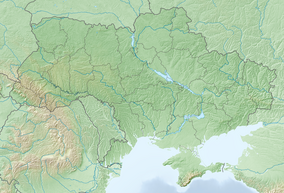This article needs additional citations for verification. (July 2022) |
Khotyn National Nature Park (Ukrainian: Хотинський національний природний парк) is a national park of Ukraine that covers a segment of the Dniester River Canyon and the Dniester River Reservoir. It is located in the west of the country on the border with Romania. The famous Khotyn Fortress is located within the territory. The park is administratively in Dnistrovskyi Raion of Chernivtsi Oblast.[1]
| Khotyn National Nature Park | |
|---|---|
| Ukrainian: Хотинський національний природний парк | |
 View of the Hedgehog's Nose, Khotyn National Nature Park | |
| Location | Dnistrovskyi Raion, Chernivtsi Oblast |
| Nearest city | Khotyn |
| Coordinates | 48°30′00″N 26°10′00″E / 48.5°N 26.16666667°E |
| Area | 9,400 hectares (23,228 acres; 94 km2; 36 sq mi) |
| Established | 2010 |
| Governing body | Ministry of Ecology and Natural Resources (Ukraine) |
| Website | Official site:[1] |
Topography
editThe park stretches for 160 km along the Dniester River. The geology of the Dniester Canyon, cut into the surrounding plateau, includes granite and gneisses up to 2,000 million years old, as well as sedimentary and limestone rocks of the more recent Cenozoic (10–12 million years). The karst landscape in places supports numerous caves.[1]
Climate and ecoregion
editThe climate of Khotyn is Humid continental climate, warm summer (Köppen climate classification (Dfb)). This climate is characterized by large swings in temperature, both diurnally and seasonally, with mild summers and cold, snowy winters.[2][3]
Flora and fauna
editBecause of the variety of terrain, habitat, and micro-climates in the park, plant and animal diversity is very high. Over 1,500 species of vascular plants have been recorded in the area, 57 species of fish, 187 species of birds, and 40 of mammals.[1]
Public use
editBesides the Khotyn Fortress, there are a wide variety of archaeological and cultural sites in the park. Several developed excursion routes are available for hiking and ecological study.[1]
See also
editReferences
edit- ^ a b c d e "Khotyn National Nature Park" (in Ukrainian). Official Park Site. Archived from the original on January 19, 2019. Retrieved January 10, 2019.
- ^ Kottek, M.; Grieser, J.; Beck, C.; Rudolf, B.; Rubel, F. (2006). "World Map of Koppen-Geiger Climate Classification Updated" (PDF). Gebrüder Borntraeger 2006. Retrieved September 14, 2019.
- ^ "Dataset - Koppen climate classifications". World Bank. Retrieved September 14, 2019.
